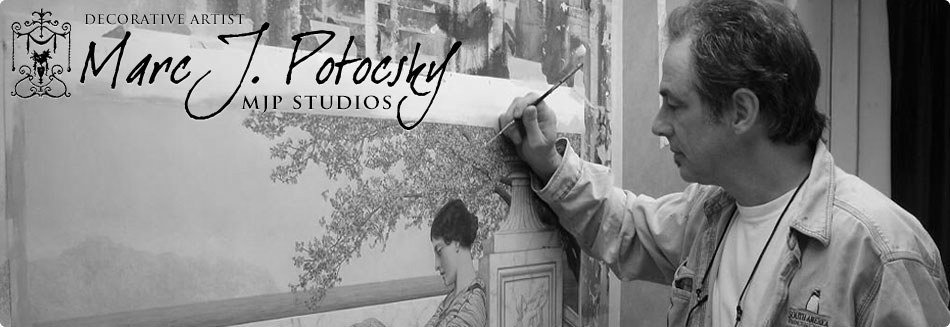Trompe l’oeil Painting Molding and Ornament by Marc Potocsky

Trompe l’oeil Painting – Faux painted Yellow sienna marble-Trompe loeil molding and ornament – Marc Potocsky CT
Trompe l’oeil Painting Molding and Ornament by Marc Potocsky
One of the most prominent features of Trompe loeil painting historically has been painted architecture , molding and bas relief ornament. Trompe loeil molding done correctly, tricks the eye into thinking that a surface, i.e., flat wall has 3 dimensions. Trompe l’oeil Painting.

Trompe loeil painted molding CT detail – Totally flat surface-Marc Potocsky

Trompe l’Oeil Painting -faux painted cherry wood and trompe loeil molding MJP Studios
Trompe l’oeil (Pronounced- Trump loy) literally translates from French to mean “fools the eye.” Hard to paint, the trompe l’oeil piece requires meticulous attention to detail on the part of the artist. Proper sizing and every detail, nuance of light and gradation of color must be skillfully incorporated in order to make the two-dimensional work appear to be three-dimensional.

Trompe l’Oeil Painting- marble fruit bowl- Marc Potocsky CT

Trompe loeil painting architectural rosett’s-Painted Sky Ceiling Greenwich CT. MJP Studios

Trompe-loeil-ornament and molding Marc Potocsky mjp studios ct
As a decorative painter this one of my favorite techniques. Stay tuned for other upcoming articles on trompe loeil painting.
See more: https://mjpfaux.com/trompe-loeil-painted-ornament/
https://mjpfaux.com/trompe-loeil-painting/
Post : Trompe loeil Painting part 1
Trompe-l’œil (French for deceive the eye, pronounced [tʁɔ̃p lœj]), which can also be spelled without the hyphen and ligature in English as trompe l’oeil,[1] is an art technique that uses realistic imagery to create the optical illusion that the depicted objects exist in three dimensions. Forced perspective is a comparable illusion in architecture. (Wikipedia).
“The Classic Art of Fine Decorative Painting, Decoration, Trompe l’oeil Murals, Faux Finishes & Patinas”
MJP Studios • 241 Branford Road, Unit 254 • North Branford, CT. 06417


















